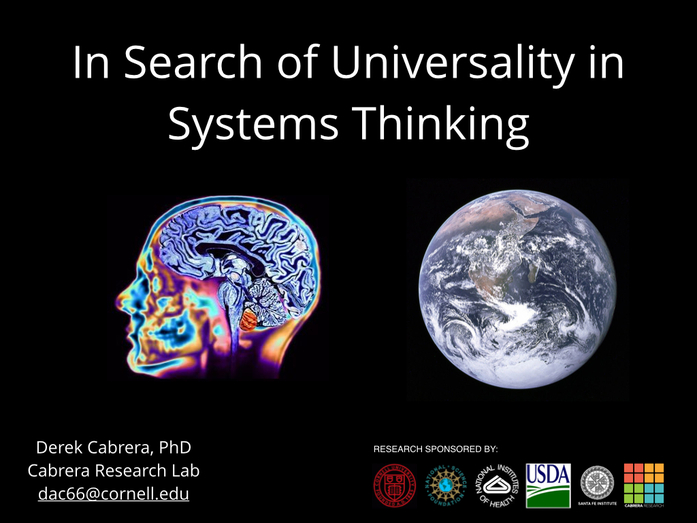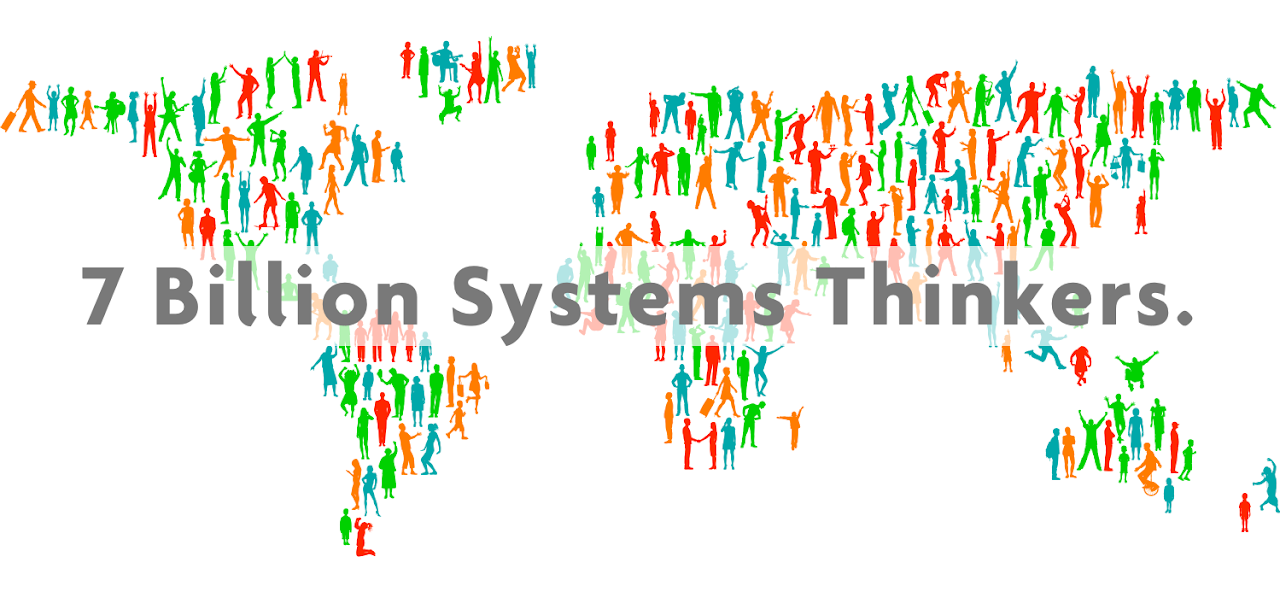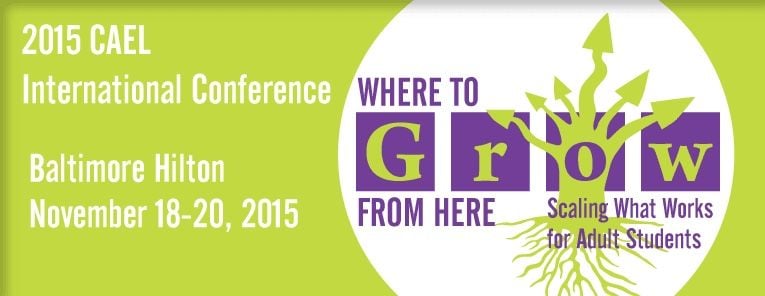Dr. Cabrera's Keynote at the E3 Ed Conference
 Derek & Laura Cabrera
·
20 minute read
Derek & Laura Cabrera
·
20 minute read
A Vision and Mission for Educators: Engage, Educate, and Empower Thinkers in Classrooms, Schools, and Districts

Please use the following citation: Cabrera, D. (2014) The Simple Idea behind E3. Keynote presentation for the E3 Education Conference, Ithaca City School District, Ithaca, NY. http://www.cabreraresearch.org/blogs/keynote-for-the-e3-education-conference
Thank you for having me. As you might have noticed, I am not, Sir Ken Robinson. I’m sorry you won’t be able to hear Sir Ken today but I’m sure you join me in wishing him and his family well. I was scheduled to speak after Sir Ken and was asked to take on the difficult job of speaking in his stead when we heard news of his family emergency. I know how excited you were to see him, so I hope I won’t be a source of utter disappointment.
In my defense, what I have to say, is far more interesting than what he was going to say…
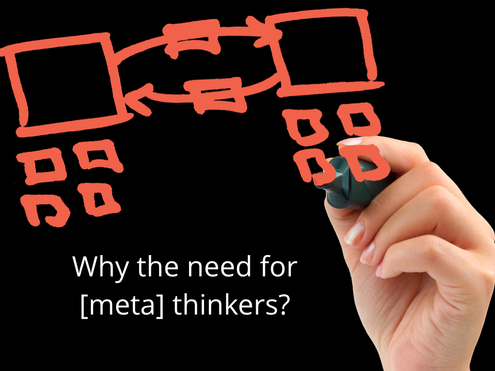
What I’d like to talk about is the need for a particular type of thinker in the world - called meta-thinkers, or what scientists call metacognitive thinkers. Meta-thinkers are people who have an awareness of how they think, and maintain that awareness when they are thinking about anything and everything. Meta-thinking isn’t a new idea, it’s what Buddhists and lefties call consciousness or self-awareness. What is new is that scientists have recently discovered new things about how we can be more metacognitive, how teachable and learnable it is, and the noteworthy outcomes that can result.
Now, about this conference's theme--E³. I hope you leave today having learned that E³ is more than a catchy logo or memorable catch phrase for this conference. E³ is a deep and meaningful construct that is the basis for revolutionary changes in education, most notably the purposeful development of meta-thinking, from student to superintendent.
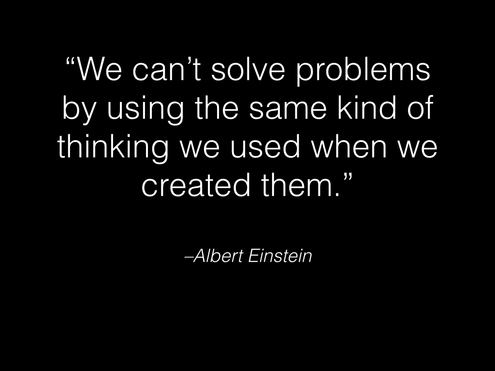
But, first, why do we need meta-thinkers? You may have heard that Einstein said, “We can’t solve problems by using the same kind of thinking we used when we created them.”
That’s really the epitome of meta-thinking. Because, most of the problems we face in our own lives, or globally in the world, are problems of our own making. We created them with a particular mindset, and to solve them, we’ll need to unseat that mindset and entertain a new one. A hard truth we must face is that our biggest problems result from a mismatch between the way the world works and the way we think.
Let’s take a look at how we get ourselves into trouble when we don’t do enough meta-thinking with a few examples...

Here’s a recipe for a disaster near you, brought to you by a lack of meta-thinking…
Ultra smart, entitled, amoral Wall St. traders, with little care or consciousness of the global effects of their selfish actions, an utter disregard for others, and a gift for self-indulgent justification, find a loophole in the law and drive a truck through it.
Unconscious but otherwise upstanding citizens with just the right amount of gullibility convince themselves that too-good-to-be-true, might just be true and take loans that far outpace their earnings.
Foreclosures are rampant. Markets crash. Recession ensues. Iceland goes bankrupt.
Political leaders motivated by fear and favoritism concoct an idea that some “banks are just too big to fail” and then double down by failing to prosecute the individuals behind the banks, instead giving them the job of fixing the problem they created.

Here’s another disaster that’s already in production and we’re all part of it…
Martin Blaser, author of Missing Microbes, explains that antibiotic use is rising in astronomic proportions, especially in children. In particular, parents who do not question their own assumptions and who dearly want to protect their children, are giving antibiotics at a rate of 1000 courses per 1,300 babies in a year!
On average, children receive 17 doses of antibiotics before they’re just 20 years old. The downstream effects of this behavior are extremely dangerous because the bacteria these young people are carrying become resistant to antibiotics—Blaser says, “a cold becomes an untreatable pneumonia, a knee injury becomes MRSA, and people die.”
According to the CDC, the number one health threat to us this year is antibiotic resistance and coping with untreatable infections, affecting two million people a year in the US alone.

And of course there are countless classic examples of lack of meta-thinking that never get old. This one is about a solution that led to big problems, literally, downstream…
Pests were killing crops and decreasing production yields in industrial farms across America. The solution: employ pesticide sprays that included nitrates as the active ingredient. Hundreds of millions of tons of nitrates seeped into the ground water, and then into the streams, river basins, and eventually into the Mississippi making its way down to the Delta, where the nitrates interacted with the sun to create a toxic “dead zone” in one of the world’s largest shrimp and crab fisheries. This caused shrimpers to take their boats farther out to sea to find the catch that used to be onshore. This required more boat fuel, which had gone up in price, due to the consequences of a war in the gulf. The cost of dinner at Red Lobster just went up. Meanwhile, bees, who pollinate plants and increase crop yields are now dying off in droves likely, too, because of the pesticides that were designed to increase crop yields.

This next example is closer to home.
I was in Dick’s Sporting Goods the other day and saw a mother and a boy around eight years old waiting in line at the check out counter. At the end of the counter was a beverage fridge designed to manipulate the less metacognitive shoppers to buy a refreshing drink while they waited in line. The overweight boy begged his mother for a Pepsi and I could see the mom think it through and then explain to the boy that it was early and that Pepsi was full of sugar and chemicals. The boy was saddened that he couldn’t have what PepsiCo and Dick’s wanted him to want. Then the boy came up with an alternative based on his mother’s concerns, and said, “Okaaay, can I have a gatorade?” To which his mother said, “yes.”
Gatorade is only a fraction healthier than Pepsi and there was water in the same cooler. Bottled of course.
Metacognition isn’t just for individuals. Organizations can use metacognition too. Because, think about it -- if this child becomes obese over his lifetime, the amount of sports equipment he needs will decline proportionally. And Dick’s might have just sold themselves out of a customer for life by not thinking it through…
The need for metacognitive awareness is as pedestrian as it gets. Our everyday lives and in particular, the lives of our children, involve navigating a gauntlet of manipulative tactics, from social media, advertising, and product campaigns. The only inoculation against this series of manipulations is metacognition.
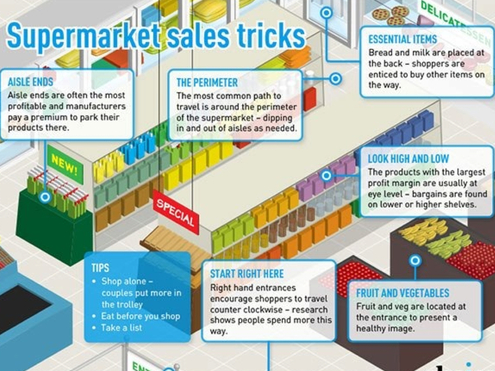
Look at the many manipulations you’ll find at your local supermarket all designed to influence your choices and maximize their profits. There’s:
right side entry of the store to encourage more spending through counterclockwise shopping,
fruits and vegetables up front to give a healthy vibe,
shelf space and end caps available to the highest bidder so that you naturally notice the most expensive items at eye level and
essential and common items like milk and eggs at the back of the store, placed there not for your convenience but designed to manipulate you to buy more than what you came for.
Who knew that a harmless errand to the grocery store could be so full of manipulations, swindlers, and schemers...

But our kids won’t be inoculated against these swindlers, they won’t learn to think for themselves, and they won’t be empowered to solve our most pressing problems if…
We spend most of our time knowing in front of them, instead of getting them to build knowledge in front of us.
If we spend our time telling them what to think, instead of teaching them how to think.
if we spend our time teaching subjects and not enough time teaching humans; and
If we spend too much time preparing them to do well in school and on tests and not enough time developing the whole person through thinking and preparing them for life.
And here’s why…

That’s the number of Top 10 jobs of 2013 that existed just six years earlier in 2007.
We are arming our children with knowledge that’s already out-of-date, to get a future job that doesn’t exist today, use technology that hasn’t been invented yet, and solve unpredictable problems, in a world we can only imagine.
We cannot predict where life’s journey will take our children, but if we prepare them to think, they will thrive.
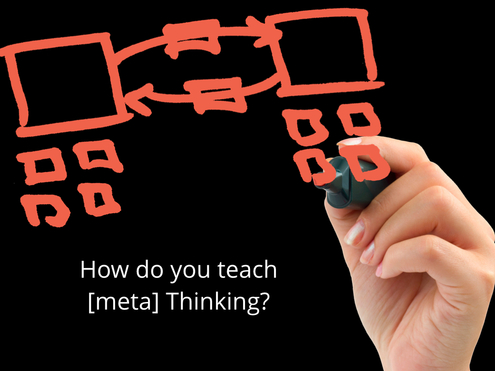
So, how do you teach meta-thinking?
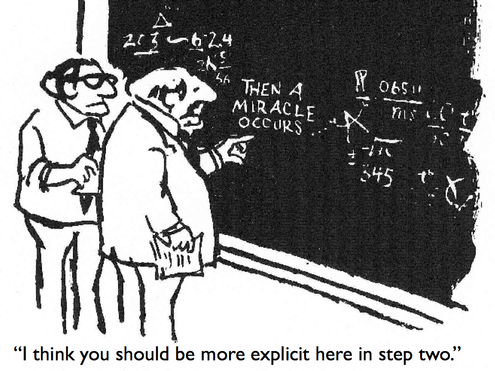
In ten years of working in the trenches with teachers and schools, preceded by 15 years of working in the trenches as an educator myself, I can honestly say that I’ve never met anyone who disagrees that it would be nice to have a society full of thinking people and that schools (in concert with families and communities) are the place to make it so.
And while everyone agrees that we should teach thinking, there are a lot of people who don’t know how to teach thinking.
There are also some others who have strange ideas about how to do it. The most popular of this latter bunch is the, “let’s teach a critical thinking course sophomore year” crowd. Of course that’s too late and too short. Thinking isn’t something we teach once or twice and hope they get it. Thinking is something we do in order to make meaning.
Yet, I’ve also met a lot of people who believe, or hope, or pray, that thinking will just occur as a byproduct of teaching subject matter. Of course, it doesn’t, anymore than thorough knowledge of the Battle of Saratoga will occur as a byproduct of not teaching it explicitly.
Funny story. I was in a classroom not too long ago and a little boy in fifth grade said to his teacher, “Ms. Thompson, you keep asking me to think about it, and I have no idea what you mean by that. What do you want me to do?”
This little boy’s question sums up the problem. We are not explicit about what it means to think. We behave as if it just happens. And that kids just do it. And the result is that a lot of kids think of their brain in much the same way that they think of their heart--its an organ, it has a job to do and it does it...no intervention necessary. When we teach them that their mind is something that can be self-directed and understood, its often an epiphany for them.
We also act as if there is some optimal time to get kids learning how to think. In truth, it’s ALWAYS an opportune time developmentally for the child - it starts when they are born and ends -- never.
We focus much of the K-12 process on teaching kids what to think, and we need also to spend time teaching kids how to think. And, we can teach how to think through what they are learning; not in addition to content, but as a way to get a deep understanding of subject matter.
What we must do is use the subject matter we are teaching as a guide, as a medium, for teaching thinking. So, we are teaching thinking all the time, through the subject matter, not separate from it. This approach will foster a deep understanding of both what kids need to learn and the process of how they learn.
The truth is that we know exactly how to teach kids to be metacognitive, all we need is the will to do so. We know that the all human minds use just four patterns of thinking to transform lifeless information into meaningful knowledge. These four patterns of thinking are already occurring in every moment in your classrooms and all we need to do is point out that they are happening... so we can make the thinking that is going on, explicit.

These are the four patterns of thinking that combine together at lightning speed in the human mind to transform information about any topic or subject into meaning. Making these patterns known to your students, helps them to slow down their mind and watch it as if it were in slow motion...
We make distinctions between things and other things, by creating a boundary between identity and other
We systematize things into groups, sorts, and categories by putting parts into wholes.
We make action-reaction relationships between and among things and systems of things
We take perspectives on things, establishing both point and a view.
We make distinctions, systems, relationships, and perspectives, or d,s,r, and p, not as separate acts but as integral. One cannot occur without the others. They are simultaneous.
Here’s a few examples that capture these four patterns of meta-thinking… 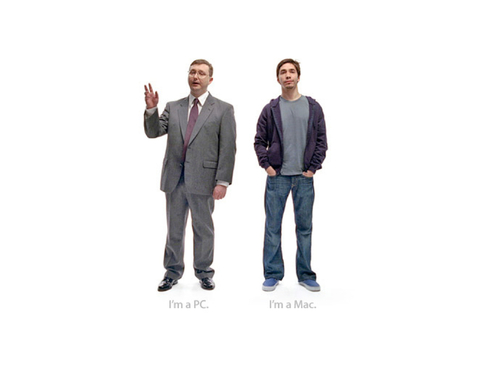
You’ll all recognize the I’m a mac commercials. The gist of this fun and effective campaign was to make a distinction between the aesthetically beautiful, simple to use Mac, and the stodgy, out-of-date, PC.
Making distinctions are a universal thing that’s happening throughout the day in your classrooms. Distinguishing between PC and Mac is no different than distinguishing between the Civil War and the Revolutionary War, mathematical expressions or equations, or the colors of a rainbow…
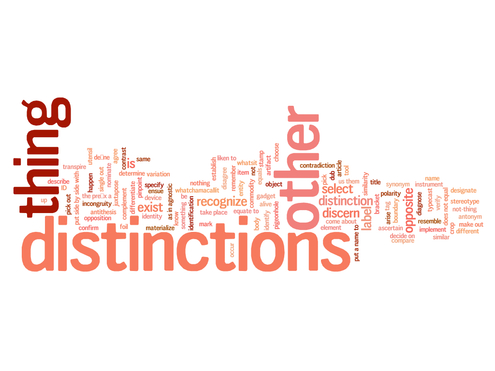
Becoming aware that we make distinctions makes us conscious of how we draw or define the boundaries of an idea or a system of ideas. Whenever we draw a boundary to define some thing, that same boundary defines what is not that thing (the "other"). Any boundary we make is a distinction between two fundamentally important elements: the identity of the thing, and the other stuff that is not the thing. When we understand that all thoughts are comprised of distinct boundaries we become aware that we focus on one thing at the expense of other things. Distinction making allows us to simplify our thinking, yet it also introduces biases that may go unchecked when unaware. It is distinction making that allows us to "pass a coffee cup" when asked, but it is also distinction making that creates us/them concepts that lead to closed mindedness or worse alienation, bullying, and violence. Distinctions are a part of every thought-act or speech-act, as we do not form words without having formed distinctions first.
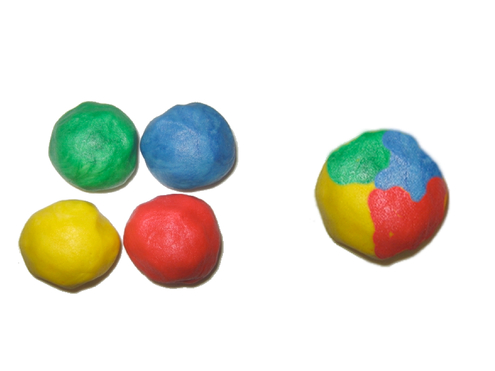
Another pattern of metacognition that’s happening all the time in your classroom is part-whole thinking. Your students constantly construct and deconstruct ideas by breaking things down into parts, or creating new wholes.
When a student realizes that the only difference between an expression and an equation is an equal sign, that’s part-whole thinking.
When a student breaks down the major issues of a historical event to better understand it and then selects a few of these parts to present a summary of his findings, that’s part-whole thinking.
When small child takes apart classroom routines to learn what it means to be part of a classroom community, that’s part-whole thinking.
It’s often said that there are two types of thinkers, splitters and lumpers—those who split stuff apart and synthesizers who lump things together. We need to teach all children to be splumpers.
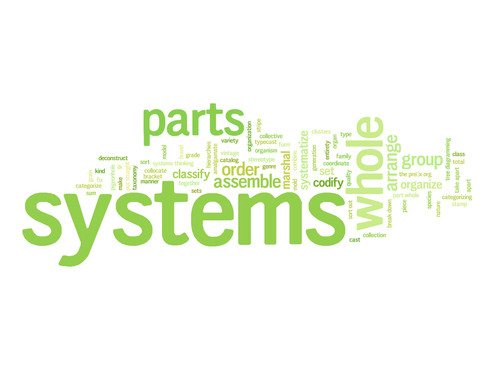
When we become aware that our mind is always breaking things down into parts or splumping them into whole systems, we realize that any topic, subject or situation is better understood by breaking it down or putting it back together again. Every book contains chapters containing paragraphs, that contain sentences, that contain words with letters, made up of ink strokes which are comprised of pixels made up of atoms. To construct or deconstruct meaning is to organize different ideas into part-whole configurations. A change in the way the ideas are organized leads to a change in the meaning itself. Every system can become a part of some larger system. The process of thinking about things means that we must draw a distinction where we stop zooming in, or zooming out. The act of thinking is defined by splitting things up or lumping ideas together. Nothing exists in isolation, but in systems of context. We can study the parts separated from the whole or the whole generalized from the parts, but in order to gain understanding of any system, we must do both in the end.

Once we break things into parts, we need to think about how the parts are related, and that’s the third pattern of meta-thinking. Relationships are often hidden, so we need to teach kids to make them explicit. For example, when I type the phrase, lobster dog, into google, the relationship is invisibly hidden in the space between the two words…
but you’d be surprised just how many people…

...have dressed their dogs up as a lobster.
This is a silly example of relationships, but remember that your kids are already making connections all the time, your job is to help them realize that its a powerful metacognitive skill that helps them understand things in all subjects. 
We cannot understand much about any thing or idea or system of things without understanding the relationships between or among them. So, it is critical that students become conscious of the fact that understanding anything involves understanding its relationships. There are many important types of relationships: causal, correlative, feedback, inputs/outputs, influence, direct/indirect, etc. And, there are relationships at every level of scale: between atoms, molecules, cells, neurons, humans, groups, countries, even planets and galaxies. At the most fundamental level though, all relationships require that we consider two underlying elements: action and reaction, or the co-relating effects of two or more things. Gaining an awareness of the numerous interrelationships around us forms an ecological ethos that connects us in an infinite network of interactions. Action-reaction relationships are not merely important to understanding physical systems, but are an essential metacognitive trait for understanding human social systems and the essential interplay between the three parts of mind: our thoughts, feelings, and motivations; or what scientists call cognition, emotion, and conation.

The other day I read a news article… Turtle crime is on the rise. A few days ago a snail was mugged by two turtles. When the police arrived, they asked the snail, “what happened?”
The snail said, “I don’t know, it all happened... so... fast…”
You laugh, but did you know that in the split second it took you to see the humor in that joke, you unconsciously took three different perspectives? You did. The joke isn’t funny unless you distinguish between a human, turtle, and snail’s perspective of speed.
So everything your students think—about history, math, english, art, music, sports, themselves and their friends, is framed by perspectives. 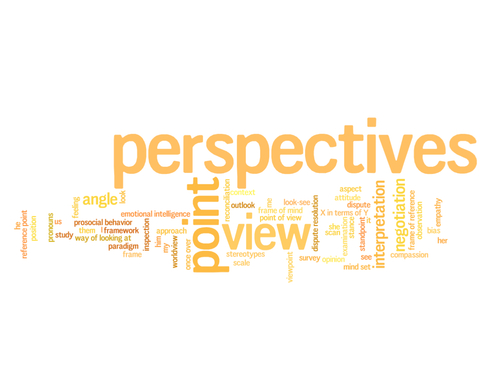
When we make distinctions, group or sort things into part-whole or draw relationship between ideas, we are always doing so from a particular perspective. So, becoming aware of perspectives makes us more metacognitive and conscious of what our minds are thinking. Sometimes these perspectives are so basic and so unconscious we don't even see them (like in the joke I just told), but they are always there. If we think about perspectives in a fundamental way, we can see that they are made up of two related elements: a point from which we are viewing and the thing or systems of things that are in the view. That's why perspectives are synonymous with a "point-of-view." Awareness of the value of taking perspective and being aware of the perspectives one takes (and equally important, the perspectives we don’t take) is paramount to deeply understanding oneself and the world around us. There is a saying that, "If you change the way you look at things, the things you look at change." When we shift perspective, we also transform the distinctions, relationships, and systems that we see and do not see.
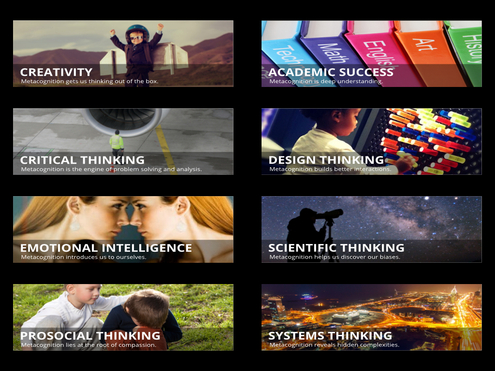
These four meta-thinking skills might seem pretty simple, but when students learn them they become aware of how they think; it’s as if they are being introduced to their minds for the very first time… and, a number of remarkable outcomes occur.
They don’t just learn the four skills, they actually develop skillsets in eight different areas:
They’ll become Creative Thinkers who are inventive, insightful, and imaginative, able to create new ideas, innovations, inventions, and energy.
They’ll become Critical Thinkers who think analytically, identify biases, and sees flaws in logic; and ask intelligent questions to seek deeper understanding.
They’ll be Emotionally Intelligent people who are aware of their mental models, emotions and motivations; have empathy and compassion for self and others, and possess grit, perseverance and tenacity in pursuit.
They’ll become Prosocial Thinkers who recognize themselves as citizens of a larger community by considering others, and developing effective communication and deep listening skills.
They’ll be Academically successful by becoming knowledge-able through building ideas rather than memorizing facts and becoming information-full.
They’ll become Design Thinkers who can build things, ideas or processes based on their essential form and function, and develop the most appropriate solution under existing constraints.
They’ll become Scientific Thinkers who can think independently, acknowledge their biases, be open minded, and seek evidence to support their theories about reality.
And finally, they’ll become Systems Thinkers who see the wider context of a situation to avoid unintended outcomes or consequences.
All of these forms of thinking, which we all want for our children, are the outcomes of teaching the four patterns of meta-thinking. And, they are the essence of what it means to develop the whole child or to teach humans, not subjects. 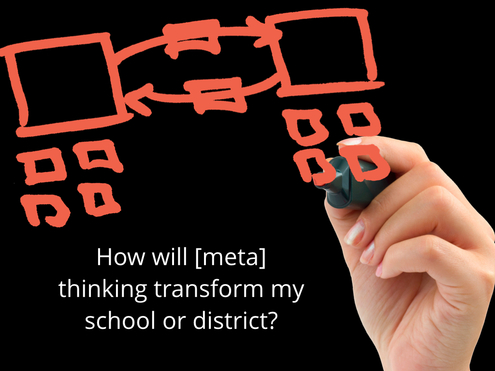
Meta-thinking alone can transform your school or district if you follow what successful districts have discovered through implementation. Let me share a few of those insights from the districts and schools we’ve had the delight to work with over the last decade... 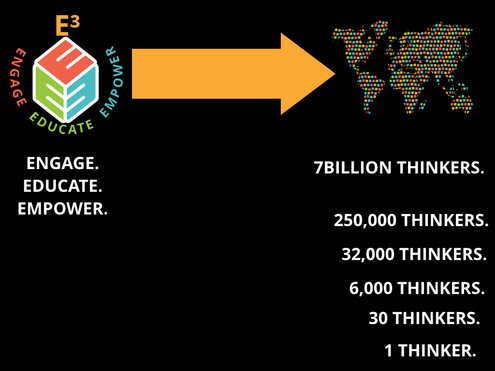
Ten years ago, Laura and I were concerned that our Ivy League students could "do school" but lacked basic meta-thinking skills like problem solving, creativity, emotional intelligence, and grit. We decided to take our research on metacognition out from the tower-and into-the-trenches.
We started doing talks around the country to anyone who would listen, and those talks really hit a nerve. Our concern about our students was shared among business, educational and political leaders, and parents, teachers, and students.
Energized by this overwhelming response, we embarked on an audacious Vision-Mission: to Engage, Educate, and Empower 7 Billion Thinkers. Our Vision-Mission was for our research lab, to keep us focused and on track on a daily basis and to build the culture of our lab.
But, a year later, a Principal named Christina Dickens from Fairfax County Public Schools in Virginia approached me with a novel request: "Can we, um, adopt your Vision and Mission?" Chris wanted to use our lab’s Vision-Mission and culture building strategies for her entire school, to train her teachers, and transform her school into what she called a, “think school.”
”Sure," I said, without realizing that this would lead to an E³ thinking revolution in education.
Today, districts, schools, and teachers across the USA are "adopting" our Vision-Mission as their own. Like Chris’s school is committed to Engaging, Educating, and Empowering the Thinkers the world needs, many other districts, principals, and individual teachers have taken responsibility for developing thinkers in their community with significant qualitative and quantitative results.
In 2012, ICSD began training teachers to develop meta-thinking skills in students across the district and Dr. Brown and the ICSD Board adopted our Vision-Mission to Engage, Educate, and Empower 6000 Thinkers. Since then, the graduation rate has climbed to 90% (from 78%) and students were above state and national averages on standardized test scores. The qualitative effects on students and teachers are even more pronounced.
So, there are districts all over the country ranging from 250,000 to 600 thinkers as their Vision, all of which are helping to Engage, Educate, and Empower Thinkers.
And, there are tens of thousands of independent teachers who have also counted themselves and their students into this Vision-Mission. From one to one hundred thinkers, it all adds up, and today we are reaching close to one million thinkers and counting…

So, there’s a universal Vision-Mission that resonates for any district, school, or teacher. What Chris Dickens did, and what many other districts today are doing -- including right here at ICSD-- is to adopt this Vision and Mission.
The Vision keeps your district focused on what matters most—transforming students into meta-thinkers. The mission tells each person in the organization the simple things that need to be done everyday in every student interaction, over and over again to accomplish this vision. 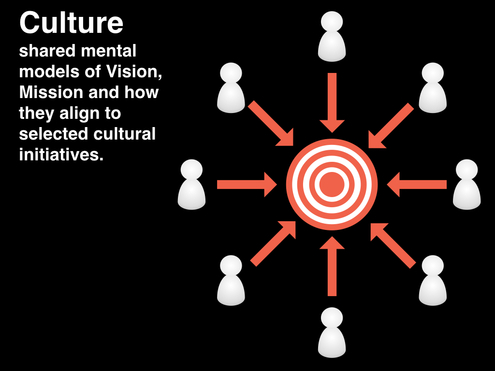
Our most successful District leaders enculturate the Vision-Mission throughout so that everything that goes on in that district is focused and aligned to the Vision-Mission. That means that the district initiatives are all framed by the Vision and Mission and that everyone in the district is on the same page.
Let me give you an example of how ICSD and others have done it. They are working hard to ensure that their four cultural initiatives are completely aligned with their Vision-Mission to Engage, Educate, and Empower 6000 Thinkers.
They have four cultural initiatives and each of them is getting in alignment:
The first initiative is Metrics that Matter: To change a district for the better we need to think of tests and grades as the low bar and deep understanding, transfer, metacognition, and whole-person development as the high bar. To do so, we'll need to shift focus to metrics that matter: metrics that show authentic engagement (e.g., attendance, voluntary enrollment, etc); education that involves thinking (e.g., deep understanding, thinking analytics); and empowerment (e.g., graduation rates, etc).
The second initiative is a Professional Learning Network, or PLN; the establishment of a community for district leadership, staff, teachers, parents, community, and students to learn more about the district’s audacious Vision, Mission, and Cultural Initiatives and learn share the best practices, methods, techniques and technologies that make it possible including the seven things teachers can do to transform their classrooms into a thinking classroom.
The third initiative involves Curriculum design: The curriculum design process, learning modules, and daily lessons must reflect a commitment to the district’s Vision-Mission. Districts work to design curriculum and learning experiences that transform students into well-rounded, thinking citizens. That all starts with what they teach and how they teach it.
The fourth initiative is a Culture Campaign: A culture campaign can make thinking the topic of discussion across the district, including students, teachers and the community. In the same way that educational leaders once developed "Reading is FUNdamental" campaigns, successful districts launch a Think! campaign, to remind everyone that thinking is fundamental to developing both a deep understanding of subjects and themselves - for every student.
Culture is the most powerful leverage for change available to any organization. Many leaders and leadership training programs get this wrong, thinking that top-down strategic planning is what matters most. But, while it takes a little longer to build, it lasts a lifetime and is built from the ground up, not top down. Culture can be built purposefully because culture is, simply, the sharing of mental models. The primary thing that a culture must share is the same Vision and Mission. Leaders that have had success, understood that Vision and Mission are not statements in a frame on the wall, but must be shared mental models in the hearts and minds of everyone in the district and the community. 
A great example of these efforts is the ThinkDistrict pages that superintendents or principals can create that help the entire community better understand and engage with the transformational change that is underway…
Visitors to the page can learn more about the Vision and Mission and the research behind meta-thinking, learn about the major district initiatives and how they are driven by the Vision-Mission, and keep learning together as a district by hearing about what we call “Wow! stories”. All of the resources teachers, students, parents, board members, and community members need to spread the word and build culture and alignment across the organization. And, there’s near total transparency, which has a lot of benefits. 
Similarly, teachers are creating their own ThinkClassroom pages where they get to claim their part of the Vision, share the Mission and the culture initiatives of their classroom with students, parents, and colleagues.
The effect is that while everyone is aligned across the district, they are also laser focused on what they need to do in their little part of the pond. 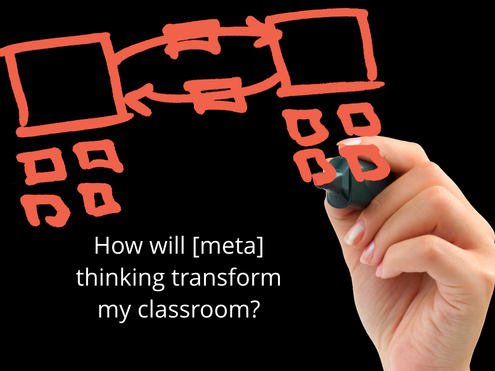
These principles of Vision-Mission and Culture are readily applied in the classroom. Teachers are transparent with their students about the Vision and Mission and use seven important culture change initiatives to transform their classroom into a ThinkClassroom.
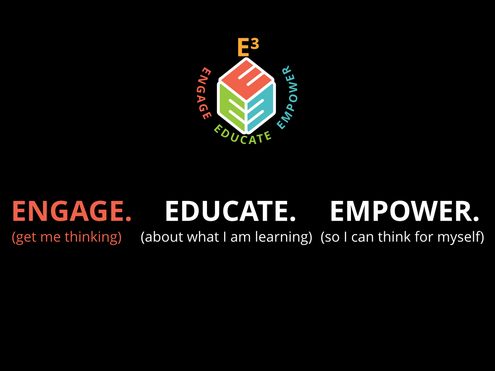
At its core, to engage, means to get students thinking.
It means authentic student engagement. This can best be understood by making a distinction among authentic engagement and its counterparts: strategic and ritual compliance, rebellion, and retreatism.
Thinking lies at the root of authentic engagement. We know that students build knowledge by thinking (or creating meaning) about Information. Thinking acts upon information and causes students to build Knowledge and it is also the root action of true engagement. Engagement simply means that students are thinking about the topic of the lesson. We often think that the best way to engage a student is to make it fun, but think about your own patterns of engagement. You are often the most engaged when your mind is engaged, interested, not bored. Sometimes its fun, but sometimes its not. Fun can be engaging, but thinking is always engaging.
We also think that the A students are engaged, and F students are not. That’s not always true. I know, I was an F student. It's not as simple as that, and here is why: authentic engagement is very different than strategic compliance.
Strategic and/or ritual compliance is a form of faux-engagement where learners are engaged in some other extrinsic or intrinsically motivated thing. For example, they may be motivated by grades and choose strategies to maximize their grade that simultaneously lessen their learning. As is often the case, it is quite possible that our "top students" are not authentically engaged but are instead strategically compliant; they have learned how to "do school" but are not developing a deep understanding of the topics of study. These compliance behaviors can be redirected toward authentic engagement by engaging kids through their thinking about the topic at hand. Strategically compliant students are thinking about how to game the system to get the grade whereas authentically engaged students are thinking about their learning.
Rebellion is a form of misdirected faux-engagement. Rather than punishing or controlling rebellious behavior, we should redirect its energy toward authentic engagement. Rebellion is often seen as dis-engagement, but, it is actually a sign of the desire to engage, coupled with the need for help in how to do it.
Retreatist behavior is of greatest concern-- because a student has given up, shutdown, or disengaged entirely. It is the opposite of engagement and should be taken seriously. It requires an intervention and concerted effort to connect with the student.
The existence of any of these behaviors (compliance, rebellion, and/or retreatism) is an important feedback mechanism we must attend to, because it indicates that something about the school or classroom culture is disincentivizing authentic engagement.
Engagement is synonymous with “get me thinking.”
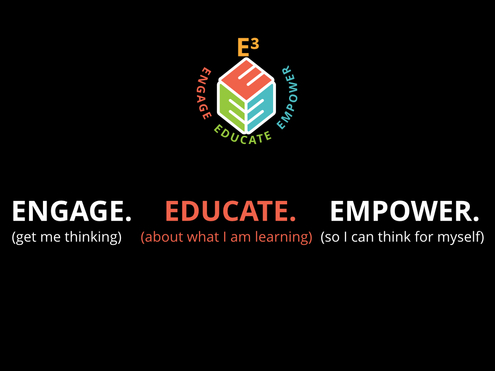
The second part of the mission is to Educate.
Again, we must move beyond the dictionary definition to build a deeper, shared common model of what educate means. The most frequent definition is simply to teach (someone), such that learning occurs. So, to understand educate, we must define learning. Learning is commonly thought of as the acquisition of, or a change in, Knowledge. And as mentioned above, students build Knowledge by giving meaning to Information by structuring it through the process of Thinking. Note that all students are making distinctions, organizing part-whole systems, recognizing relationships, and taking multiple point-view perspectives to build meaning of content. Our commitment to learning is exemplified by an important (or fundamental) question of teaching and learning: How are my learners building their ideas?
Of equal importance is the recognition that learners can get information but they cannot "get" knowledge. They must build it through the process of thinking - so we need to teach them how they think while they are learning information. Effective education employs multiple techniques, and classroom tools that engage all of their senses (visual, tactile, kinesthetic) to engage and educate them through their thinking processes.
The third part of the mission is Empower.
To engage is to think. To educate is to get students building and grounding ideas. To empower is simply to transfer, over time, the role of teacher to the student. Thus, if the student has the capacity to play the role of teacher to themselves, they become a life-long learner. The student becomes the master of their own learning.
Empowerment is fundamentally metacognitive because if the student understands how they build knowledge to make it meaningful, they can teach themselves anything.
That's empowerment, in a nutshell.
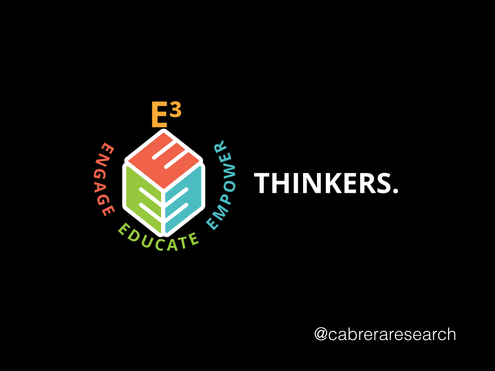
Society needs meta-thinkers, and as educators, its our job to create these thinkers…
If we allow ourselves to get distracted by all the noise of bureaucracies and politics, if we allow ourselves to make it more complicated than it really is, then we allow ourselves to get distracted from the one thing we have control over—the moment when we get to do the best job in the world—develop young people into whatever they can be.
On the other hand, if we stay laser focused on our Vision to develop young people into thinkers, and understand that three simple things, done by many, can lead to big changes, we will see our schools transform much faster than we expected.
Engage. get me thinking
Educate. about what I am learning
Empower. so I can think for myself
Get me thinking, about what I am learning, so I can think for myself.
Society desperately needs us. Our students need us. Get unstuck. Free yourself up. Join the revolution.
Thank you and enjoy the conference. We can entertain some questions if there is time.
.png?width=150&height=150&name=CRL%20GOAT%20Logo%20(4).png)
